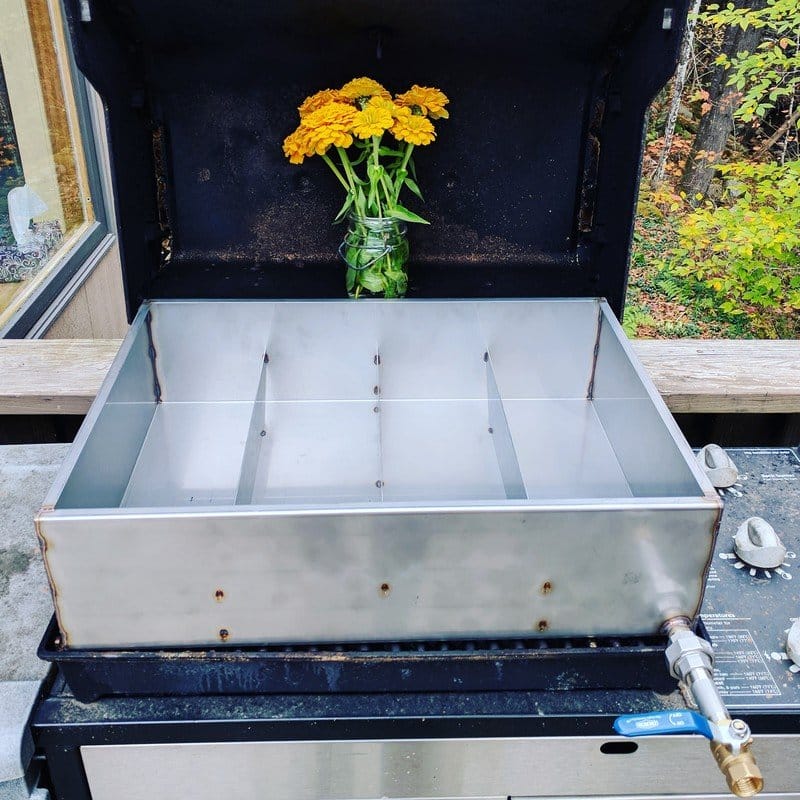Seedling Urban Evaporator is a Continuous-Flow Pan and thus More Efficient than a Lobster Pot
People responded so well to my last blog post that I decided to keep it technical this week. Let’s, as promised, talk about why a continuous-flow pan—like the Sapling Evaporator Pan, and the NEW Seedling Urban Evaporator—beat a flat pan for maple sugaring.
To address this question, I brought in Expert-of-Sorts, Andy Boutin, General Manager of Pellergy, and, conveniently, co-lessor of 157 Pioneer Center, Suite 1. As Andy was moving stuff around our shared warehouse, I shouted questions at him, and he shouted back, pausing every once in a while to draw me a diagram. Here’s how our high-volume conversation went:
Kate: People want to know why continuous-flow evaporators are more efficient than evaporating on a flat pan. I gather the answer lies in understanding a principle of physics called a “gradient.” I’m trying to figure out what a gradient is, what it has to do with sugaring, and how a continuous-flow evaporator exploits that principle to make more syrup in less time. Can you help?
Andy: Yes.
Kate: Wait. What did you study again?
Andy: Marine Engineering and Naval Architecture.
Kate: Hmm. But that involved a lot of Physics classes, right?
Andy: Yes. There’s a lot of fluid dynamics in that education, with ships and man submersibles traveling through water at different densities. It’s relatable.
Kate: Sold! Why is a continuous-flow pan better for sugaring than a flat pan and what does it have to do with the “gradient.” According to Lord Google, gradient is defined as “an increase or decrease in the magnitude of a property (e.g., temperature, pressure, or concentration) observed in passing from one point or moment to another.” What does that have to do with the price of syrup?
Andy: Lord Google is correct, of course, but that’s not how I would explain it. Let’s back up.
Gradient is “physics” for as you move through space or time, something that can be measured changes gradually over the course of that distance. So, on a hot summer day, in a house with no internal doors (or doors that are open), if you climb the stairs from the basement to the first floor, the first floor to the second floor, and the second floor to the attic, you travel through a temperature gradient. A gradient is a gentle slope, not a cliff, and is not the result of a physical barrier. So, when, on that same hot summer day, you cross the street and open a door to a nice, cool, air-conditioned house, you are not travelling through a temperature gradient – the change is not gradual and is the result of a physical barrier.
There are a number of gradients at play when sugaring, but probably the most important one for purposes of this discussion is the density gradient that results from changes in sugar concentration as water evaporates and sap turns to syrup.
Kate: OK, I’m with you. Are there density gradients no matter how you sugar?
Andy: Yes. But they don’t operate the same way in every pan. Envision a flat pan the same dimensions as the Sapling Evaporator Pan—20” x 30”—but with no baffles. Think about the pathway from sap to syrup in that pan. Put the sap in. Start the fire. Water boils off. You add more sap. Now you have a density gradient: the denser liquid is at the bottom of the pan and the less-dense liquid is at the top of the pan. Every time you add sap, that density gradient forms (and, by the way, you kill your boil). So you have to keep boiling and boiling until the entire pan is the same density, and then you draw it all off. That’s the batch process. The gradient works against you, not for you, when you batch.
The concentration gradient works FOR you in a continuous-flow pan, both in terms of efficiency and quality. Now take the actual Sapling Evaporator Pan—20” x 30” with two baffles—and what you have is a pan that operates as if it is a 10” x 60” pan, squashed over the firebox. Now: put the sap in, start the fire, water boils off, you add more sap to one end of the pan only, and you’ve rearranged the gradient into a flowing river, where the less dense liquid pushes the denser liquid toward the pour-off, instead of a stagnant pond with muck settling at the bottom.
Kate: That’s quite a visual. Thanks. And there are efficiency gains as well as quality gains, you say?
Andy: Yes. In the flat pan, the gradient is only as long as the pan is deep, with a baffled pan, the gradient is as long as the different channels all stretched out. The efficiency is in the continuous flow that the latter gradient arrangement allows for – there’s no time-killing start and stop to your boil. The quality gains are that when you do draw off, you are able to take off only one density of syrup, even while other densities exist in the pan simultaneously.
Kate: One last question. Is it just me, or when you Google “sugar gradient maple” does the internet try to sell you wigs and quilting fabric?
Andy: Um . . . It’s you.
That’s all, folks!

